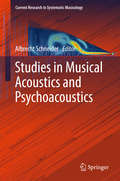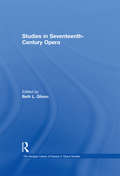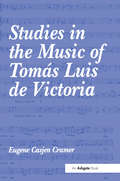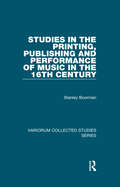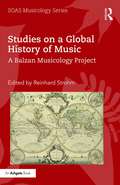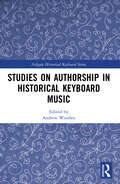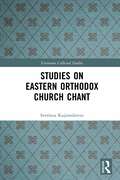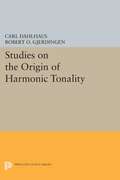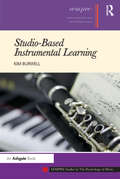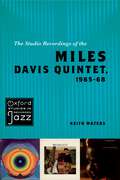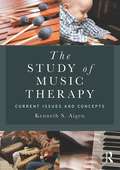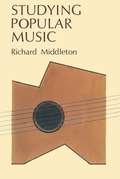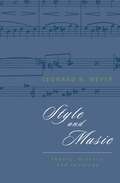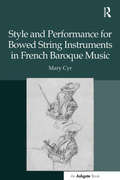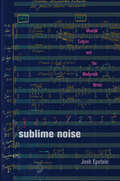- Table View
- List View
Studies in Musical Acoustics and Psychoacoustics (Current Research in Systematic Musicology #4)
by Albrecht SchneiderThis book comprises twelve articles which cover a range of topics from musical instrument acoustics to issues in psychoacoustics and sound perception as well as neuromusicology. In addition to experimental methods and data acquisition, modeling (such as FEM or wave field synthesis) and numerical simulation plays a central role in studies addressing sound production in musical instruments as well as interaction of radiated sound with the environment. Some of the studies have a focus on psychoacoustic aspects in regard to virtual pitch and timbre as well as apparent source width (for techniques such as stereo or ambisonics) in music production. Since musical acoustics imply subjects playing instruments or singing in order to produce sound according to musical structures, this area is also covered including a study that presents an artificial intelligent agent capable to interact with a real ('analog') player in musical genres such as traditional and free jazz.
Studies in Seventeenth-Century Opera
by BethL. GlixonThe past four decades have seen an explosion in research regarding seventeenth-century opera. In addition to investigations of extant scores and librettos, scholars have dealt with the associated areas of dance and scenery, as well as newer disciplines such as studies of patronage, gender, and semiotics. While most of the essays in the volume pertain to Italian opera, others concern opera production in France, England, Spain and the Germanic countries.
Studies in Seventeenth-Century Opera
by BethL. GlixonThe past four decades have seen an explosion in research regarding seventeenth-century opera. In addition to investigations of extant scores and librettos, scholars have dealt with the associated areas of dance and scenery, as well as newer disciplines such as studies of patronage, gender, and semiotics. While most of the essays in the volume pertain to Italian opera, others concern opera production in France, England, Spain and the Germanic countries.
Studies in the Music of Tomás Luis de Victoria
by EugeneCasjen CramerRepresenting nearly thirty years of research by one of the leading scholars in the field, this series of in-depth studies examines selected aspects of the music of the great Spanish composer in the late Renaissance, Tom Luis de Victoria. Presenting new insights into both the musical style and language and the compositional procedure of this contemporary of Palestrina, Lasso and Byrd, Eugene Cramer illuminates the extent to which Victoria's compositions are musically related. The book reveals that the falsobordone or fabord layed a much larger role in Victoria's music than has previously been thought. Cramer also demonstrates that Victoria's parody or imitation technique, especially in respect to his Masses of 1592, extended the parameters that are generally thought to be characteristic of works of this type. Of special interest is the discussion of thirty-eight works, including thirty-four psalm settings that are attributed to Victoria in extant manuscript sources. Extensively illustrated with over 130 musical examples, these studies will not only interest the serious student of sacred music, but also the performer, both the singer and the conductor alike.
Studies in the Music of Tomás Luis de Victoria
by EugeneCasjen CramerRepresenting nearly thirty years of research by one of the leading scholars in the field, this series of in-depth studies examines selected aspects of the music of the great Spanish composer in the late Renaissance, Tom Luis de Victoria. Presenting new insights into both the musical style and language and the compositional procedure of this contemporary of Palestrina, Lasso and Byrd, Eugene Cramer illuminates the extent to which Victoria's compositions are musically related. The book reveals that the falsobordone or fabord layed a much larger role in Victoria's music than has previously been thought. Cramer also demonstrates that Victoria's parody or imitation technique, especially in respect to his Masses of 1592, extended the parameters that are generally thought to be characteristic of works of this type. Of special interest is the discussion of thirty-eight works, including thirty-four psalm settings that are attributed to Victoria in extant manuscript sources. Extensively illustrated with over 130 musical examples, these studies will not only interest the serious student of sacred music, but also the performer, both the singer and the conductor alike.
Studies in the Printing, Publishing and Performance of Music in the 16th Century
by Stanley BoormanThe emergence of music printing and publishing in the early 16th century radically changed how music was circulated, and how the musical source (printed or manuscript) was perceived, and used in performance. This series of close studies of the structure and content of 16th-century and early 17th-century editions (and some manuscripts) of music draws conclusions in a number of areas - printing techniques for music; the habits of different type-setters and scribes, and their view of performing practice; publishers' approaches to the musical market and its abilities and interests; apparent changes of plan in preparing editions; questions of authorship; evidence in editions and manuscripts for interpreting different levels of notation; ways in which scribes could influence performers' decisions, and others by which composers could exploit unusual sonorities.
Studies in the Printing, Publishing and Performance of Music in the 16th Century
by Stanley BoormanThe emergence of music printing and publishing in the early 16th century radically changed how music was circulated, and how the musical source (printed or manuscript) was perceived, and used in performance. This series of close studies of the structure and content of 16th-century and early 17th-century editions (and some manuscripts) of music draws conclusions in a number of areas - printing techniques for music; the habits of different type-setters and scribes, and their view of performing practice; publishers' approaches to the musical market and its abilities and interests; apparent changes of plan in preparing editions; questions of authorship; evidence in editions and manuscripts for interpreting different levels of notation; ways in which scribes could influence performers' decisions, and others by which composers could exploit unusual sonorities.
Studies on a Global History of Music: A Balzan Musicology Project (SOAS Studies in Music Series)
by Reinhard StrohmThe idea of a global history of music may be traced back to the Enlightenment, and today, the question of a conceptual framework for a history of music that pays due attention to global relationships in music is often raised. But how might a historical interpretation of those relationships proceed? How should it position, or justify, itself? What would 'Western music' look like in an account of music history that aspires to be truly global? The studies presented in this volume aim to promote post-European historical thinking. They are based on the idea that a global history of music cannot be one single, hegemonic history. They rather explore the paradigms and terminologies that might describe a history of many different voices. The chapters address historical practices and interpretations of music in different parts of the world, from Japan to Argentina and from Mexico to India. Many of these narratives are about relations between these cultures and the Western tradition; several also consider socio-political and historical circumstances that have affected music in the various regions. The book addresses aspects that Western musical historiography has tended to neglect even when looking at its own culture: performance, dance, nostalgia, topicality, enlightenment, the relationships between traditional, classical, and pop musics, and the regards croisés between European, Asian, or Latin American interpretations of each other’s musical traditions. These studies have been derived from the Balzan Musicology Project Towards a Global History of Music (2013–2016), which was funded by the International Balzan Foundation through the award of the Balzan Prize in Musicology to the editor, and designed by music historians and ethnomusicologists together. A global history of music may never be written in its entirety, but will rather be realised through interaction, practice, and discussion, in all parts of the world.
Studies on a Global History of Music: A Balzan Musicology Project (SOAS Studies in Music Series)
by Reinhard StrohmThe idea of a global history of music may be traced back to the Enlightenment, and today, the question of a conceptual framework for a history of music that pays due attention to global relationships in music is often raised. But how might a historical interpretation of those relationships proceed? How should it position, or justify, itself? What would 'Western music' look like in an account of music history that aspires to be truly global? The studies presented in this volume aim to promote post-European historical thinking. They are based on the idea that a global history of music cannot be one single, hegemonic history. They rather explore the paradigms and terminologies that might describe a history of many different voices. The chapters address historical practices and interpretations of music in different parts of the world, from Japan to Argentina and from Mexico to India. Many of these narratives are about relations between these cultures and the Western tradition; several also consider socio-political and historical circumstances that have affected music in the various regions. The book addresses aspects that Western musical historiography has tended to neglect even when looking at its own culture: performance, dance, nostalgia, topicality, enlightenment, the relationships between traditional, classical, and pop musics, and the regards croisés between European, Asian, or Latin American interpretations of each other’s musical traditions. These studies have been derived from the Balzan Musicology Project Towards a Global History of Music (2013–2016), which was funded by the International Balzan Foundation through the award of the Balzan Prize in Musicology to the editor, and designed by music historians and ethnomusicologists together. A global history of music may never be written in its entirety, but will rather be realised through interaction, practice, and discussion, in all parts of the world.
Studies on Authorship in Historical Keyboard Music (Ashgate Historical Keyboard Series)
by Andrew WoolleyAuthorship is a pertinent issue for historical musicology and musicians more widely, and some controversies concerned with major figures have even reached wider consciousness. Scholars have clarified some of the issues at stake in recent decades, such as the places of borrowing and arranging in the creative process and the wider cultural significance of these practices. The discovery of new sources and methodologies has also opened up opportunities for reassessing specific authorship problems. Drawing upon this wider musicological literature as well as insights from other disciplines, such as intellectual history and book history, this book aims to build on what has already been achieved by focussing on keyboard music. The nine chapters cover case studies of authorship problems, the socioeconomic conditions of music publishing, the contributions of composers, arrangers, copyists and music publishers in creating notated keyboard compositions, the functions of attribution and ascription, and how the contexts in which notated pieces were used affected concepts of authorship at different times and places.
Studies on Authorship in Historical Keyboard Music (Ashgate Historical Keyboard Series)
by Andrew WoolleyAuthorship is a pertinent issue for historical musicology and musicians more widely, and some controversies concerned with major figures have even reached wider consciousness. Scholars have clarified some of the issues at stake in recent decades, such as the places of borrowing and arranging in the creative process and the wider cultural significance of these practices. The discovery of new sources and methodologies has also opened up opportunities for reassessing specific authorship problems. Drawing upon this wider musicological literature as well as insights from other disciplines, such as intellectual history and book history, this book aims to build on what has already been achieved by focussing on keyboard music. The nine chapters cover case studies of authorship problems, the socioeconomic conditions of music publishing, the contributions of composers, arrangers, copyists and music publishers in creating notated keyboard compositions, the functions of attribution and ascription, and how the contexts in which notated pieces were used affected concepts of authorship at different times and places.
Studies on Eastern Orthodox Church Chant (Variorum Collected Studies)
by Svetlana KujumdzievaThis book focuses on the compilation of the different practices of Eastern Orthodox Chant, looking at the subject through various languages, practices, and liturgical books and letters. The subject of this book is also analysed through newly found, unique material, to provide the entire history of Eastern Orthodox Chant, from the ninth to the nineteenth centuries and approached through a number of different disciplines. The book consists of sixteen topics, grouped in four parts: Studies on Genre, Studies on Liturgical Books, Studies on Distinguished Men of Letters, and Studies on Bulgarian Orthodox Church Chant. The aim of the book is to present the Eastern chant as a phase in the evolution of Mediterranean art, which is the cradle of Graeco-Roman heritage. This complex study brings in a variety of sources to show the purpose of Eastern Orthodox Chant as strengthening the Christian faith during the Middle Ages and the revival of Balkan nationalism in the nineteenth century. This book will appeal to students and scholars alike, interested in liturgical musical books, liturgy, and chant repertory. Likewise, it will be of interest to those engaged in medieval and early modern history, music, and culture.
Studies on Eastern Orthodox Church Chant (Variorum Collected Studies)
by Svetlana KujumdzievaThis book focuses on the compilation of the different practices of Eastern Orthodox Chant, looking at the subject through various languages, practices, and liturgical books and letters. The subject of this book is also analysed through newly found, unique material, to provide the entire history of Eastern Orthodox Chant, from the ninth to the nineteenth centuries and approached through a number of different disciplines. The book consists of sixteen topics, grouped in four parts: Studies on Genre, Studies on Liturgical Books, Studies on Distinguished Men of Letters, and Studies on Bulgarian Orthodox Church Chant. The aim of the book is to present the Eastern chant as a phase in the evolution of Mediterranean art, which is the cradle of Graeco-Roman heritage. This complex study brings in a variety of sources to show the purpose of Eastern Orthodox Chant as strengthening the Christian faith during the Middle Ages and the revival of Balkan nationalism in the nineteenth century. This book will appeal to students and scholars alike, interested in liturgical musical books, liturgy, and chant repertory. Likewise, it will be of interest to those engaged in medieval and early modern history, music, and culture.
Studies on the Origin of Harmonic Tonality
by Carl Dahlhaus Robert O. GjerdingenCarl Dahlhaus was without doubt the premier musicologist of the postwar generation, a giant whose recent death was mourned the world over. Translated here for the first time, this fundamental work on the development of tonality shows his complete mastery of the theory of harmony. In it Dahlhaus explains the modern concepts of harmony and tonality, reviewing in the process the important theories of Rameau, Sechter, Ftis, Riemann, and Schenker. He contrasts the familiar premises of chordal composition with the lesser known precepts of intervallic composition, the basis for polyphonic music in the late Middle Ages and Renaissance. Numerous quotations from theoretical treatises document how early music was driven forward not by progressions of chords but by simple progressions of intervals.Exactly when did composers transform intervallic composition into chordal composition? Modality into tonality? Dahlhaus provides extensive analyses of motets by Josquin, frottole by Cara and Tromboncino, and madrigals by Monteverdi to demonstrate how, and to what degree, such questions can be answered. In his bold speculations, in his magisterial summaries, in his command of eight centuries of music and writings on music, and in his deep understanding of European history and culture, Carl Dahlhaus sets a standard that will seldom be equalled.Originally published in 1990.The Princeton Legacy Library uses the latest print-on-demand technology to again make available previously out-of-print books from the distinguished backlist of Princeton University Press. These editions preserve the original texts of these important books while presenting them in durable paperback and hardcover editions. The goal of the Princeton Legacy Library is to vastly increase access to the rich scholarly heritage found in the thousands of books published by Princeton University Press since its founding in 1905.
Studio-Based Instrumental Learning (SEMPRE Studies in The Psychology of Music)
by Kim BurwellIn Studio-Based Instrumental Learning, Kim Burwell investigates the nature of lesson interactions in instrumental teaching and learning. Studio lesson activity is represented as a private interaction, dealing with skill acquisition and reflecting a tradition based in apprenticeship, as well as the personal attributes and intentions of participants. The varied and particular nature of such interaction does not always lend itself well to observation or - when observed - to easy interpretation. This presents particular problems for practitioners wishing to share aspects of professional knowledge, and for researchers seeking to explain the practice. Focusing on a single case study of two clarinet lessons, Burwell uses video observations and interviews to analyse collaborative lesson activity, through the 'rich transcription' of performance, verbal and nonverbal behaviours. The foregrounded lesson interactions are also contextualised by the background consideration of social, cultural and institutional frameworks. The research is aimed a helping to create a framework that can support reflection among practitioners as they continually develop their work, not only experientially - through the tradition of 'vertical transmission' from one musician to another - but collaboratively, through the 'horizontal' sharing of good practice.
Studio-Based Instrumental Learning (SEMPRE Studies in The Psychology of Music)
by Kim BurwellIn Studio-Based Instrumental Learning, Kim Burwell investigates the nature of lesson interactions in instrumental teaching and learning. Studio lesson activity is represented as a private interaction, dealing with skill acquisition and reflecting a tradition based in apprenticeship, as well as the personal attributes and intentions of participants. The varied and particular nature of such interaction does not always lend itself well to observation or - when observed - to easy interpretation. This presents particular problems for practitioners wishing to share aspects of professional knowledge, and for researchers seeking to explain the practice. Focusing on a single case study of two clarinet lessons, Burwell uses video observations and interviews to analyse collaborative lesson activity, through the 'rich transcription' of performance, verbal and nonverbal behaviours. The foregrounded lesson interactions are also contextualised by the background consideration of social, cultural and institutional frameworks. The research is aimed a helping to create a framework that can support reflection among practitioners as they continually develop their work, not only experientially - through the tradition of 'vertical transmission' from one musician to another - but collaboratively, through the 'horizontal' sharing of good practice.
The Studio Recordings of the Miles Davis Quintet, 1965-68 (Oxford Studies in Recorded Jazz)
by Keith WatersThe "Second Quintet" -- the Miles Davis Quintet of the mid-1960s -- was one of the most innovative and influential groups in the history of the genre. Each of the musicians who performed with Davis--saxophonist Wayne Shorter, pianist Herbie Hancock, bassist Ron Carter, and drummer Tony Williams--went on to a successful career as a top player. The studio recordings released by this group made profound contributions to improvisational strategies, jazz composition, and mediation between mainstream and avant-garde jazz, yet most critical attention has focused instead on live performances or the socio-cultural context of the work. Keith Waters' The Studio Recordings of the Miles Davis Quintet, 1965-68 concentrates instead on the music itself, as written, performed, and recorded. Treating six different studio recordings in depth--ESP, Miles Smiles, Sorcerer, Nefertiti, Miles in the Sky, and Filles de Kilimanjaro--Waters has tracked down a host of references to and explications of Davis' work. His analysis takes into account contemporary reviews of the recordings, interviews with the five musicians, and relevant larger-scale cultural studies of the era, as well as two previously unexplored sources: the studio outtakes and Wayne Shorter's Library of Congress composition deposits. Only recently made available, the outtakes throw the master takes into relief, revealing how the musicians and producer organized and edited the material to craft a unified artistic statement for each of these albums. The author's research into the Shorter archives proves to be of even broader significance and interest, as Waters is able now to demonstrate the composer's original conception of a given piece. Waters also points out errors in the notated versions of the canonical songs as they often appear in the main sources available to musicians and scholars. An indispensible resource, The Miles Davis Quintet Studio Recordings: 1965-1968 is suited for the jazz scholar as well as for jazz musicians and aficionados of all levels.
The Studio Recordings of the Miles Davis Quintet, 1965-68 (Oxford Studies in Recorded Jazz)
by Keith WatersThe "Second Quintet" -- the Miles Davis Quintet of the mid-1960s -- was one of the most innovative and influential groups in the history of the genre. Each of the musicians who performed with Davis--saxophonist Wayne Shorter, pianist Herbie Hancock, bassist Ron Carter, and drummer Tony Williams--went on to a successful career as a top player. The studio recordings released by this group made profound contributions to improvisational strategies, jazz composition, and mediation between mainstream and avant-garde jazz, yet most critical attention has focused instead on live performances or the socio-cultural context of the work. Keith Waters' The Studio Recordings of the Miles Davis Quintet, 1965-68 concentrates instead on the music itself, as written, performed, and recorded. Treating six different studio recordings in depth--ESP, Miles Smiles, Sorcerer, Nefertiti, Miles in the Sky, and Filles de Kilimanjaro--Waters has tracked down a host of references to and explications of Davis' work. His analysis takes into account contemporary reviews of the recordings, interviews with the five musicians, and relevant larger-scale cultural studies of the era, as well as two previously unexplored sources: the studio outtakes and Wayne Shorter's Library of Congress composition deposits. Only recently made available, the outtakes throw the master takes into relief, revealing how the musicians and producer organized and edited the material to craft a unified artistic statement for each of these albums. The author's research into the Shorter archives proves to be of even broader significance and interest, as Waters is able now to demonstrate the composer's original conception of a given piece. Waters also points out errors in the notated versions of the canonical songs as they often appear in the main sources available to musicians and scholars. An indispensible resource, The Miles Davis Quintet Studio Recordings: 1965-1968 is suited for the jazz scholar as well as for jazz musicians and aficionados of all levels.
The Study of Music Therapy: Current Issues And Concepts
by Kenneth S. AigenThis book addresses the issues in music therapy that are central to understanding it in its scholarly dimensions, how it is evolving, and how it connects to related academic disciplines. It draws on a multi-disciplinary approach to look at the defining issues of music therapy as a scholarly discipline, rather than as an area of clinical practice. It is the single best resource for scholars interested in music therapy because it focuses on the areas that tend to be of greatest interest to them, such as issues of definition, theory, and the function of social context, but also does not assume detailed prior knowledge of the subject. Some of the topics discussed include defining the nature of music therapy, its relation to current and historical uses of music in human well-being, and considerations on what makes music therapy work. Contemporary thinking on the role of neurological theory, early interaction theory, and evolutionary considerations in music therapy theory are also reviewed. Within each of these areas, the author presents an overview of the development of thinking, discusses contrasting positions, and offers a personalized synthesis of the issue. The Study of Music Therapy is the only book in music therapy that gathers all the major issues currently debated in the field, providing a critical overview of the predominance of opinions on these issues.
The Study of Music Therapy: Current Issues And Concepts
by Kenneth S. AigenThis book addresses the issues in music therapy that are central to understanding it in its scholarly dimensions, how it is evolving, and how it connects to related academic disciplines. It draws on a multi-disciplinary approach to look at the defining issues of music therapy as a scholarly discipline, rather than as an area of clinical practice. It is the single best resource for scholars interested in music therapy because it focuses on the areas that tend to be of greatest interest to them, such as issues of definition, theory, and the function of social context, but also does not assume detailed prior knowledge of the subject. Some of the topics discussed include defining the nature of music therapy, its relation to current and historical uses of music in human well-being, and considerations on what makes music therapy work. Contemporary thinking on the role of neurological theory, early interaction theory, and evolutionary considerations in music therapy theory are also reviewed. Within each of these areas, the author presents an overview of the development of thinking, discusses contrasting positions, and offers a personalized synthesis of the issue. The Study of Music Therapy is the only book in music therapy that gathers all the major issues currently debated in the field, providing a critical overview of the predominance of opinions on these issues.
Studying Popular Music (UK Higher Education OUP Humanities & Social Sciences Media, Film & Cultural Studies)
by Richard MiddletonA critical analysis of issues and approaches in a variety of areas, ranging from the political economy of popular music through its history and ethnography to its semiology, aesthetics and ideology. The book focuses on Anglo-American popular music of the last 200 years.
Style and Music: Theory, History, and Ideology
by Leonard B. MeyerLeonard Meyer proposes a theory of style and style change that relates the choices made by composers to the constraints of psychology, cultural context, and musical traditions. He explores why, out of the abundance of compositional possibilities, composers choose to replicate some patterns and neglect others. Meyer devotes the latter part of his book to a sketch-history of nineteenth-century music. He shows explicitly how the beliefs and attitudes of Romanticism influenced the choices of composers from Beethoven to Mahler and into our own time. "A monumental work. . . . Most authors concede the relation of music to its cultural milieu, but few have probed so deeply in demonstrating this interaction."—Choice "Probes the foundations of musical research precisely at the joints where theory and history fold into one another."—Kevin Korsyn, Journal of American Musicological Society "A remarkably rich and multifaceted, yet unified argument. . . . No one else could have brought off this immense project with anything like Meyer's command."—Robert P. Morgan, Music Perception "Anyone who attempts to deal with Romanticism in scholarly depth must bring to the task not only musical and historical expertise but unquenchable optimism. Because Leonard B. Meyer has those qualities in abundance, he has been able to offer fresh insight into the Romantic concept."—Donal Henahan, New York Times
Style and Performance for Bowed String Instruments in French Baroque Music
by Mary CyrMary Cyr addresses the needs of researchers, performers, and informed listeners who wish to apply knowledge about historically informed performance to specific pieces. Special emphasis is placed upon the period 1680 to 1760, when the viol, violin, and violoncello grew to prominence as solo instruments in France. Part I deals with the historical background to the debate between the French and Italian styles and the features that defined French style. Part II summarizes the present state of research on bowed string instruments (violin, viola, cello, contrebasse, pardessus de viole, and viol) in France, including such topics as the size and distribution of parts in ensembles and the role of the contrebasse. Part III addresses issues and conventions of interpretation such as articulation, tempo and character, inequality, ornamentation, the basse continue, pitch, temperament, and "special effects" such as tremolo and harmonics. Part IV introduces four composer profiles that examine performance issues in the music of Élisabeth Jacquet de La Guerre, Marin Marais, Jean-Baptiste Barrière, and the Forquerays (father and son). The diversity of compositional styles among this group of composers, and the virtuosity they incorporated in their music, generate a broad field for discussing issues of performance practice and offer opportunities to explore controversial themes within the context of specific pieces.
Style and Performance for Bowed String Instruments in French Baroque Music
by Mary CyrMary Cyr addresses the needs of researchers, performers, and informed listeners who wish to apply knowledge about historically informed performance to specific pieces. Special emphasis is placed upon the period 1680 to 1760, when the viol, violin, and violoncello grew to prominence as solo instruments in France. Part I deals with the historical background to the debate between the French and Italian styles and the features that defined French style. Part II summarizes the present state of research on bowed string instruments (violin, viola, cello, contrebasse, pardessus de viole, and viol) in France, including such topics as the size and distribution of parts in ensembles and the role of the contrebasse. Part III addresses issues and conventions of interpretation such as articulation, tempo and character, inequality, ornamentation, the basse continue, pitch, temperament, and "special effects" such as tremolo and harmonics. Part IV introduces four composer profiles that examine performance issues in the music of Élisabeth Jacquet de La Guerre, Marin Marais, Jean-Baptiste Barrière, and the Forquerays (father and son). The diversity of compositional styles among this group of composers, and the virtuosity they incorporated in their music, generate a broad field for discussing issues of performance practice and offer opportunities to explore controversial themes within the context of specific pieces.
Sublime Noise: Musical Culture and the Modernist Writer (Hopkins Studies in Modernism)
by Josh EpsteinWhen Stravinsky’s Rite of Spring premiered in Paris in 1913, the crowd rioted in response to the harsh dissonance and jarring rhythms of its score. This was noise, not music. In Sublime Noise, Josh Epstein examines the significance of noise in modernist music and literature. How—and why—did composers and writers incorporate the noises of modern industry, warfare, and big-city life into their work?Epstein argues that, as the creative class engaged with the racket of cityscapes and new media, they reconsidered not just the aesthetic of music but also its cultural effects. Noise, after all, is more than a sonic category: it is a cultural value judgment—a way of abating and categorizing the sounds of a social space or of new music. Pulled into dialogue with modern music’s innovative rhythms, noise signaled the breakdown of art’s autonomy from social life—even the "old favorites" of Beethoven and Wagner took on new cultural meanings when circulated in noisy modern contexts. The use of noise also opened up the closed space of art to the pressures of publicity and technological mediation.Building both on literary cultural studies and work in the "new musicology," Sublime Noise examines the rich material relationship that exists between music and literature. Through close readings of modernist authors, including James Joyce, T. S. Eliot, Edith Sitwell, E. M. Forster, and Ezra Pound, and composers, including George Antheil, William Walton, Erik Satie, and Benjamin Britten, Epstein offers a radically contemporary account of musical-literary interactions that goes well beyond pure formalism. This book will be of interest to scholars of Anglophone literary modernism and to musicologists interested in how music was given new literary and cultural meaning during that complex interdisciplinary period.
